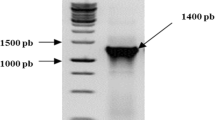Summary
Guinea pigs were injected with tunicamycin and the sequential morphological alterations in the brain examined to investigate further the pathogenesis of cerebral lesions in this experimental model of annual ryegrass toxicity, a central nervous system disease of livestock caused by members of the tunicamycin group of antibiotics. Brain damage was most commonly observed in the cerebellum, and the important alterations in the development of degenerative parenchymal lesions appeared to be largely referrable to changes in small blood vessels. Endothelial damage, with increased vascular permeability, resulted in capillary obstruction leading to localised ischaemia and hypoxic neuronal damage. There was evidence for several possible mechanisms which may have contributed to vascualr occlusion.
Similar content being viewed by others
References
Adams RD, Lee JC (1982) Neurons and neuronal reactions in disease states. In: Haymaker W, Adams RD (eds) Histology and histopathology of the nervous system. Thomas, Springfield, pp 174–248
Azmi TI, O'Shea JD (1984) Mechanism of deletion of endothelial cells during regression of the corpus luteum. Lab Invest 51:206–217
Berry PH, Cook RD, Howell JMcC, White RR, Purcell DA (1976) Lesions in sheep and guinea pigs fed parasitized annual ryegrass (Lolium rigidum). Aust Vet J 52:540–541
Berry PH, Howell JMcC, Cook RD (1980) Morphological changes in the central nervous system of sheep affected with experimental annual ryegrass (Lolium rigidum) toxicity. J comp Pathol 90:603–617
Bourke RS, Kimelberg HK, Nelson LR, Barron KD, Auen EL, Popp AJ, Waldman JB (1980) Biology of glial swelling in experimental brain oedema. Adv Neurol28:99–109
Brierley JB (1976) Cerebral hypoxia. In: Blackwood W, Corsellis JAN (eds) Greensfield's neuropathology, 3rd edn. Arnold, London, pp 43–85
Fein JM, Flor WJ, Cohan SL, Parkhurst TJ (1974) Sequential changes of vascular ultrastructure in experimental cerebral vasospasm. J Neurosurg 41:49–58
Finnie JW, Jago MV (1985) Experimental production of annual ryegrass toxicity with tunicamycin. Aust Vet J 62:248–249
Finnie JW, Mukherjee TM (1986) Ultrastructural changes in the cerebellum of nursling rats given corynetoxin, aetiological agent of annual ryegrass toxicity. J Comp Pathol 96:205–216
Finnie JW, Mukherjee TM (1987) Ultrastructural changes in cerebral blood vessels of sheep injected with tunicamycin. J Comp Pathol 97:217–220
Ghadially FN (1982) Ultrastructural pathology of the cell and matrix, 2nd edn. Butterworths, London, pp 330–336
Hicks SP (1953) Developmental brain metabolism. Effects of cortisone, anoxia, fluoroacetate, radiation, insulin and other inhibitors on the embryo, newborn and adult. AMA Arch Pathol 55:302–327
Hirano A (1985) Neurons, astrocytes, and ependyma. In: Davis RL, Robertson DM (eds) Textbook of neuropathology. Williams & Wilkins, Baltimore, pp 1–91
Jago MV, Payne AL, Peterson JE, Bagust TJ (1983) Inhibition of glycosylation by corynetoxin, the causative agent of annual ryegrass toxicity: a comparison with tunicamycin. Chem Biol Interact 45:223–234
Lee JC (1982) Anatomy of the blood-brain barrier under normal and pathological conditions. In: Haymaker W, Adams RD (eds) Histology and histopathology of the nervous system. Thomas, Springfield, pp 798–843
Levine S (1960) Anoxic-ischaemic encephalopathy in rats. Am J Pathol 36:1–17
Lindenberg R (1955) Compression of brain arteries as pathogenetic factor for tissue necroses and their areas of predilection. J Neuropathol Exp Neurol 14:223–243
Lindenberg R (1982) Tissue reactions in the grey matter of the central nervous system. In: Haymaker W, Adams RD (eds) Histology and histopathology of the nervous system. Thomas, Springfield, pp 973–1080
McIntosh GH, Rac R, Thomas MR (1967) Toxicity of parasitized Wimmera ryegrass,Lolium rigidum, for sheep and cattle. Aust Vet J 43:349–353
Norton S (1980) Toxic responses of the central nervous system. In: Doull J, Klaassen CD, Amdur MO (eds) Casarett and Doull's toxicology, 2nd edn. Macmillan, New York, pp 197–205
O'Shea JD, Nightingale MG, Chamley WA (1977) Changes in small blood vessels during cyclical luteal regression in sheep. Biol Reprod 17:162–177
Payne AL, Cockrum PA, Edgar JA, Jago MV (1983) Production of corynetoxins byCorynebacterium rathayi in liquid cultures. Toxicon [Suppl] 3:345–348
Peterson JE, Jago MV (1977) Brain damage by extracts of parasitized annual ryegrass (Lolium rigidum) in nursling rats. Aust J Exp Biol Med Sci 55:233–244
Rosenblum WI (1986) Aspects of endothelial malfunction and function in cerebral microvessels. Lab Invest 55:252–268
Spector RG (1962) Water content of the immature rat brain following cerebral anoxia and ischaemia. Br J Exp Pathol 43:472–479
Tamura G (1982) Tunicamycin. Japan Scientific Societies Press, Tokyo, pp 35–70
Author information
Authors and Affiliations
Additional information
Supported in part by a Wool Research Trust Fund grant
Rights and permissions
About this article
Cite this article
Finnie, J.W., O'Shea, J.D. Pathological and pathogenetic changes in the central nervous system of guinea pigs given tunicamycin. Acta Neuropathol 75, 411–421 (1988). https://doi.org/10.1007/BF00687795
Received:
Accepted:
Issue Date:
DOI: https://doi.org/10.1007/BF00687795



